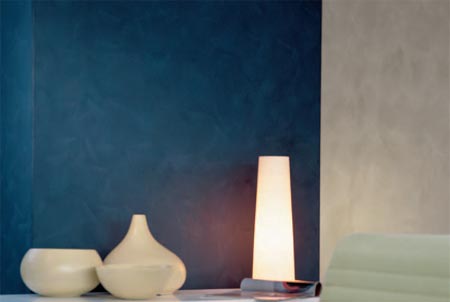Go faux for painting effect
The recent resurgence of interest in decorative paint effects shouldn’t make you think they’re new techniques: we have been using whatever has been at hand to decorate our environment for millennia. Today, homeowners still want to create an impact in the spaces we call our own. We want to express our individual style and taste and we want to do it quickly and effortlessly.
Metallic
Any surface that can be painted can be given an
authentic antiqued metallic finish. Acrylic paints
that contain finely ground metal particles are
painted onto a primed surface.
Major paint companies have made the job of creating faux effects
even easier. They have designed specially
formulated paints to give you the desired effect
without the need to dilute the paint or mix it with
anything else.
Stone effect
This finish is uniquely formulated and designed to
imitate the worn look of stone. Depending on the
application techniques this option can create a look of
soft suede fabric covering.
Glimmer
This adds a soft shimmer and a subtle sparkle to
your walls. This glistening finish produces a stylish
environment and also looks sensational when used on
small pieces of furniture.
Suede
This is a fantastic finish and yet a suede technique is so easy to apply.
The result is a warm, textured finish that you can’t help
but reach out to touch.
Pearl
As the name implies, pearl finish is a uniquely
formulated interior acrylic paint that creates
a soft pearlescent finish. This elegant effect
captures the rich lustre of a natural pearl,
leaving an effect that absorbs yet reflects light.
This paint is ideal for a dragged brush finish.
Colourwashing
This is a quick and flexible effect that is
particularly useful for disguising small
imperfections in the surface. Generally a
good guide for mixing is to use 50 per cent
acrylic paint with 50 per cent scumble glaze.
The stronger the paint colour and the paler the base coat, the stronger the effect will be. Colour washing is usually done with a broad brush using acrylic paint mixed with scumble glaze to make the wash.
The effect varies depending on the consistency of the paint mixture and the method of applying the colour. You would also apply the wash with a sponge to achieve a slightly different effect.
Dragging
You can use an ordinary paintbrush to achieve
a dragging effect but you can also use an ordinary
household broom. A special dragging brush is
also available. The coarseness of the tool used
will determine the finished effect. The technique
is very simple – drag a brush down over wet
paint in a clean line to produce a striped effect.
You can apply it using a random brush or a
dragged brush finish.
Sponging
Sponging is a simple, quick and easy technique
that is perfect for novices. You can use either a
natural sea sponge or a synthetic sponge and it
is as simple as dipping the sponge into the paint
and dabbing it on to the wall. A natural sponge
will produce smaller, finer marks while heavier
marks can be created with a synthetic sponge,
by pinching out small chunks from it. You may
find edges and corners are a bit tricky so you
could use a smaller sponge for these areas.






